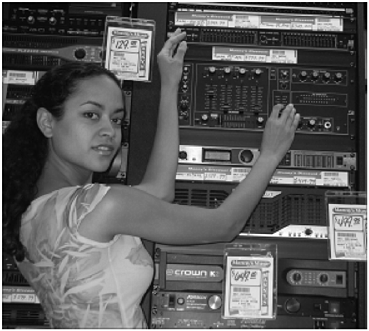In General
| [ LiB ] |
In General
Effects boxes have cool names made up by marketing drones. These names are often just reflecting whatever's happening in popular music this week. For instance, there was a fuzz pedal called the Heavy Metal Pedal. I think that it's pretty much the same circuit design they later retooled and sold as the Grunge Pedal. Ignore this crap and go with your ear and your heart and recommendations from smart musicians .
Each extra effect you add to the chain between your guitar and your amp adds a little bit more noise. When recording, only hook up the effect you want to use on that song (and maybe a noise gate at the end of the chain). When playing live, set up all your effects with the shortest cables possible to join them. Six-inch or even three-inch chords should do it.
Put the effects that add more volume to the signal first in the chain. I would put the fuzz or distortion first. That way you will be boosting the signal, not the noise.
Effects can be powered by a battery or an AC adapter. AC adapters can add noise, but batteries don't last long. Effects draw a lot of juice . Most effects draw a little power even when off as long as a cable is plugged into the input. If you're not playing for a while and you're using batteries, unplug the input side.
You can get a power supply in a music store that is made for delivering (hopefully) steady and (hopefully) noise-free power to multiple effects at the same time. Sometimes it is also mounted on a board or carrying case to make it easier to transport the effects as a single unit.
Makeup cases are useful for carrying extra junk to a gig. You can put an effect or two, your tuner, extra strings, a string winder, a slide, some batteries, and some CDs in one. And consumables and even makeup if you're into that sort of thing.
Effects are not a substitute for talent or quality songwriting . Work with your effects and get to know them as well as you know your instrument. They are basically another instrument, or at least an extension of your instrument. Learn to use all the controls on each one. Be able to get the exact sound you have in your head without having to fiddle around too much. Be able to jump to the right setting for every song instantly. Be able to jump to the right setting between songs, even between parts in a song. This is one advantage of multi-effects units: programmability.
Keep track of when the batteries are running down; the knobs will work differently and unpredictably (another reason to use an AC adapter). And learn to be able to use them in the dark, or near darkness , because sometimes it will be nearly dark on stage if the light man does a blackout between songs.
Some amps have an Effects Loop. This is an input and output on the amp where you can put your effects chain directly into the amplifier , rather than between the guitar and the amp. This gives a better sound with less added noise.
Rack Mount Effects
Some effects are not the floor box type. They are rack-mounted effects, a.k.a. a rack mount, which are higher quality, lower noise, more expensive effects, built to screw into a rack, which you buy separately. The rack usually has a power supply, a fan (to cool the electronics), and sometimes built-in light. Rack-mount effects cost more, are more complicated, do more, and sound better with less noise. Many professional players use these instead of the ones on the floor. But it's all up to you. There are advantages and disadvantages both ways.
Figure 4.12. Detail of rack-mount screw holes.

Figure 4.13. Rack-mount equipment.

| [ LiB ] |
EAN: 2147483647
Pages: 138